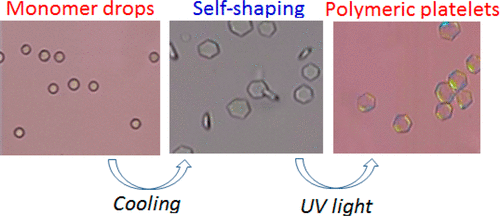Bottom-up synthesis of polymeric micro- and nanoparticles with regular anisotropic shapes

Shape-anisotropic polymeric micro- and nanoparticles are of significant interest for the development of novel composite materials, lock-and-key assemblies, and drug carriers. Currently, syntheses require external confinement in microfluidic devices or lithographic techniques associated with significant infrastructure and low productivity, so new methods are necessary to scale-up such production efficiently. Here we report bottom-up polymerization of regular shape-anisotropic particles (polygonal platelets with different numbers of edges, with and without protruding asperities, and fibrilar particles with controllable aspect ratios), with size control over 4 orders of magnitude (∼50 nm-1 mm). Polymerization also enables the study of much smaller shapes than could previously be studied in water suspensions, and we study the fundamental limits of the self-shaping transition process driving these transformations for monomer oil droplets of stearyl methacrylate (SMA) monomer oil. We show the method is compatible with a variety of polymerizing monomers and functional modifications of the particles (e.g., composites with magnetic nanoparticles, oil-soluble additives, etc.). We also describe postsynthetic surface modifications that lead to hierarchical superstructures. The synthesis procedure has great potential in efficient nanomanufacturing as it can achieve scalable production of the above shapes in a wide range of sizes, with minimum infrastructure and process requirements and little maintenance of the equipment.

